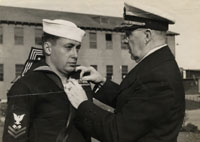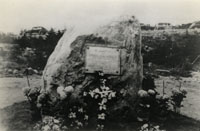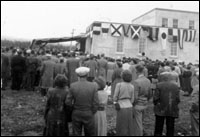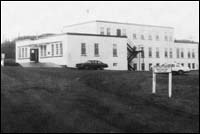Chapter 10: The Story – Dead Reckoning
Aftermath
The salvaging of bodies from the waters off Chambers Cove and Lawn Point continued for months. Forty eight were buried in a cemetery at Argentia during the first week after the disaster and another 90 at St. Lawrence in the coming months. When the war ended in 1945, the US Navy exhumed the bodies and returned them to the United States. An undetermined number of corpses were never found at all. In the coming weeks and months, parents of dead sailors sometimes wrote or telephoned various St. Lawrence residents, searching for any information they could gather about their sons.
The Navy convened a court of inquiry to investigate why the Wilkes, Truxtun, and Pollux had gone aground. It opened on February 20 and by the time it closed on March 19, was of the opinion that the commanding officers and navigators on board each vessel were responsible for the shipwrecks. Charges were laid against: Commander Walter Webb (senior officer of the convoy and onboard the Wilkes at the time of the groundings); Commander John Kelsey (captain of the Wilkes); Lieutenant Arthur Barrett (navigator of the Wilkes); Lieutenant William Smyth (officer on deck of the Wilkes); Commander Hugh Turney (captain of the Pollux); and Lieutenant William Grindley (navigator of the Pollux). Neither the Truxtun's captain, Lieutenant Commander Ralph Hickox, nor its navigator, Lieutenant Arthur Newman, survived the tragedy.
All charges were eventually dropped.
The court of inquiry gave heavy praise to the Newfoundlanders in its report, stating that: “The civilian personnel of the area near the disaster gave unstintingly of their time, labour, homes, food, and personal effects. They are considered primarily responsible for the saving of practically all the survivors of the USS Pollux and, through their care of all the survivors of the USS Pollux and the USS Truxtun, they minimized further loss through exposure.” Many of the sailors who served on the grounded vessels later received medals for their heroic actions on the day of the disaster. The following men from the Pollux received medals: Lieutenants J. W. Boundy, George Bradley, and Jack Garnaus, Ensign Alfred Pollack, and enlisted men Melvin Bettis, Lawrence Calemmo, Rex Copeland (posthumously), William DeRosa (posthumously), Alfred Dupuy, Warren Greenfield, Garrett Lloyd, Bill McGinnis (posthumously), and Henry Strauss. The following men from the Truxtun received medals: Ensign H. W. Taylor (posthumously), and enlisted men Edward Bergeron, Walter Brom (posthumously), Harry Egner, James Fex, and Edward Petterson.
As a sign of its profound thankfulness, the United States Government presented to the people of St. Lawrence and Lawn a fully-equipped state-of-the-art hospital, which it built in the town of St. Lawrence and opened on June 6, 1954. A plaque hanging behind glass inside the hospital lobby read:
Presented by the President of the United States to the people of St. Lawrence and Lawn, Newfoundland, on behalf of the people of the United States in gratitude:
For the dauntless valor displayed by the people of St. Lawrence on February 18, 1942, when during a snowstorm two ships of the United States Navy, the USS Truxtun and the USS Pollux, were wrecked on the barren and rocky coast of Newfoundland, the intrepid and selfless residents of this community at great risk to themselves as in the face of cold and high winds undertook rescue operations and gave aid and comfort to the survivors of the two ships.
The people of the United States of America in presenting this hospital, desire to express their gratitude for the fortitude and generosity displayed by the heroic people of Newfoundland on that night. It is hoped that the hospital will serve as a living memorial to the 203 officers and men of the United States Navy who lost their lives in the disaster and as a vital reminder of the inherent courage of mankind.



